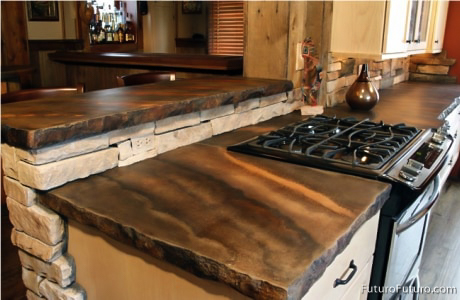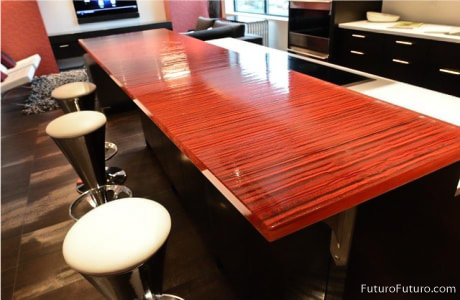Top 5 Kitchen Countertop Materials
One of the most important decisions involved in the process of planning or renovating a kitchen, is the choice of countertop materials. There are many materials available for kitchen countertops, each with their own strengths and weaknesses. In this article, we’ll provide an overview of the 5 most popular kitchen countertop materials.
Butcher Block Countertops



Butcher block countertops are made from assembled slabs of hardwood such as maple, teak, walnut, or cherry. It softens the overall look & feel of the kitchen by introducing an organic surface. This surface allows chopping and cutting directly on the counter, without the risk of dulling the knives.
End-grain butcher block is more expensive to manufacture, but withstands repeated damage from knives and cleavers, so it’s best for the heavy-use work area, while the less expensive edge-grain butcher block is more suitable for countertops other than the work area.
- Pros:
- Ideal for cooking habits that involve a lot of cutting and chopping
- Easy to install and repair
- Easy to match to wood cabinetry and other kitchen elements made from wood
- Easy to repair – scratches can be sanded out, sections can be replaced
- Easy to mix & match with other materials – marble, concrete, granite (see example)
- Cons:
- Vulnerable to moisture and heat, may not be suitable for some climates
- After food prep or spills, the surface should be cleaned immediately and thoroughly
- Requires a food-friendly sealant, which must be re-applied eventually
Ceramic Tile Countertops




With resistance to water, stains, and heat, ceramic tile is a popular countertop finishing material. It’s available in a variety of colors, textures, and styles, and it’s virtually guaranteed that you’ll find the perfect tile to match your kitchen design – whether traditional or contemporary.
Tile countertops can be inlaid with a decorative border, made out in a checkerboard pattern, or spiced up with contrasting inlays – the possibilities are endless!
- Pros:
- Easy to keep clean on a regular basis
- Very resistant to stains, scratches, heat, and spills
- Localized damage can be repaired by replacing individual tiles
- Available in a wide variety of styles, textures, and colors
- Easier to DIY, compared to single-slab marble or concrete countertops
- Cons:
- Relatively labor-intensive to install
- Possible to crack or chip the tiles with heavy cookware
- Grout between tiles may need periodic cleaning, bleaching, and/or regrouting
Concrete Countertops



An extremely versatile material that can be prefabricated or even poured into molds right on site, concrete offers a wide variety of colors, edging, and textures that allow it to match almost any kitchen style. Additives and surface treatments let concrete countertops mimic many types of stone, giving the look and feel of stone at a much lower price.
Concrete countertops also allow experimentation with elements that aren’t commonly found in countertops made from other materials. Sinks can be molded directly into the countertop; color-contrasting inserts or embedded glass mosaics can completely transform the look of the countertop; some designers even integrate illuminated areas into the surface.
- Pros:
- Very durable
- Resists scratches, scuffs, and heat damage
- Many colors, textures, edge shapes available
- Can mimic other materials; various inserts/embeds available
- Cons:
- Requires heavy cabinetry that can support the weight of the slab
- Requires periodic sealing
- Can be damaged by acidic liquids if spills are not cleaned up immediately
Glass Countertops




Glass is a relatively new material for countertops, but it’s been steadily gaining in popularity. High-quality tempered glass can provide years of service – and look good doing it.
A wide variety of glass surfaces is available, from single-color glass panels custom-cut to the shape of the counter, to individual glass tiles or sections in a stunning array of colors & designs.
It’s even possible to combine multiple layers of glass to achieve 3D effects and surface variations, or use back-paint techniques and built-in lighting to create truly spectacular designs.
- Pros:
- Resists heat, spills, and light scratches
- Easy to clean with any window cleaner
- Eco-friendly options in the form of recycled glass are available
- Cons:
- Requires frequent cleaning, spills/splatters are very obvious
- Can chip or break from hard impacts
- Usually better suited for an accent countertop or serving area, not the workspace
Laminate Countertops



Laminate counters are available in a stunning variety of colors, patterns, edge treatments, and textures. Ranging from a simple, single-color panel with flat edges to multi-tone textured finish with sculpted edges, a laminate countertop brings a spectrum of choices to kitchen design. Laminate counters resist heat, scratches, and stains, and can be easily cleaned with soap and water.
- Pros:
- Easy to clean
- Inexpensive
- Many colors, patterns, textures, and edge treatments available
- Resists damage from heat, minor scratches, and stains
- Cons:
- Difficult or impossible to repair if significantly damaged (deep scratch or scorch)
- Can be damaged by sharp knives and extremely hot cookware